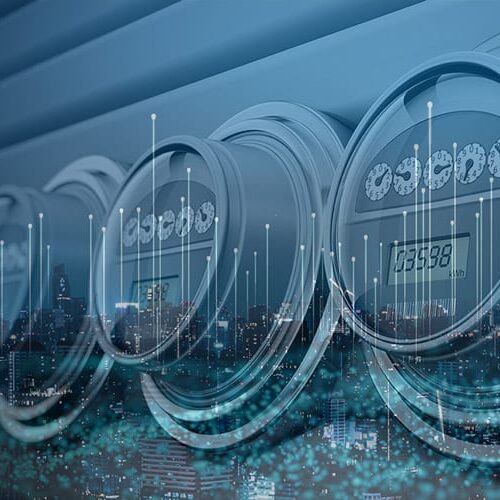How Cellular LPWA and 5G Enable Infrastructure for Smart Utilities
By Marco Stracuzzi
July 6, 2022
By Marco Stracuzzi
July 6, 2022
Grid and metering infrastructures are top of mind for forward-looking utility companies. The approach consists of an integrated system of highly connected grid components, smart meters, communication networks and data management platforms. Utilities employing the smart architecture can:
Across Europe and the U.S., smart grids and a vast status-reading sensor network are paving the way for a cost-effective, eco-friendly future. It’s a commonly held belief that smart utilities are entirely a low-data-rate and latency-tolerant space.
However, 5G (including private networks) will advance smart grids for teleprotection, real-time energy spike control, load balancing and fast energy rerouting with novel operating models.
Today, the smart metering dimension of smart utilities features cross-network connection capability for 2G, 3G, 4G LTE and even unlicensed spectrum networks. Currently, the go-to technology for smart meters is cellular LPWA (i.e., LTE-M and NB-IoT).
3GPP specified these technologies as part of the 4G LTE standard. However, LTE-M and NB-IoT have been merged under the 5G umbrella, evolving into more effective spectrum. They will power users in 5G-NR beyond 3GPP Release (Rel) 16.
5G’s impact on IoT solutions in enabling new applications across smart utilities’ functionality will be felt worldwide. Building a smart grid framework for 5G capabilities will revolutionize how the world connects us to the world around us. Expected in 2024, 5G-Advanced (3GPP Rel 18) promises to bring even more intelligence and energy efficiency to the network. 5G-Advanced (5G-A) will allow utilities to meet sustainability goals, including CO2 reduction and water use.

Smart metering enables devices to connect to water, gas, oil and electric utilities. Power companies and first responders will gain real-time wireless control with a 5G-enabled grid network. This control is achieved through analyzing data lakes filled by an infrastructure of meters and sensors monitoring consumption and variables (e.g., water and power quality).
These meters and sensors send readouts to data lakes operated by utility companies. The data is analyzed and expressed in alerts and diagnostics to help users understand their consumption patterns and behaviors.
Home consumers will save money with more accurate bills and understand consumption behavior by seeing instant usage numbers on a phone app. Gone are the days of utility companies sending someone to read the meter on their property.
Other smart utility capabilities for industrial use include sensors to regulate oil industry pipelines and equipment. They sense gas leaks and toxins in mining operations, among other practical metering applications in which safety is essential.
Utilizing smart sensors and other rising technologies, IoT innovation from solution providers to the utilities include:
The quicker the communication is between device and server, the quicker the action.
Smart grids continue to gain traction worldwide. A recent report shows the U.S. and global market growing fast.
Many infrastructures are being upgraded with 4G LTE solutions. As more devices stretch bandwidth to peak capacity, what advantages will 5G offer over 4G networks?
5G speeds and access remain focused on reaching the consumer market. As 5G rolls out more IoT-focused features on the network like ultra-reliable low-latency communication (URLLC), we will see:
Metering frameworks (e.g., gas line sensors and water meters) would be difficult to access and costly to perform maintenance on if they required battery replacement every year or two. 5G connectivity made up of LTE-M and NB-IoT options facilitates this need with:
Standards more adept at connecting multiple devices for longer durations than 2G to 4G are being developed. 5G will support over 1,000 more devices per unit area than 4G. 5G’s network slicing, compared to the present-day LTE, will allow smart energy use cases to be handled by a single network.
According to Tim Fisher with Lifewire, the difference between 4G and 5G is that 5G has the room to operate through radio frequencies unencumbered by billions of connected devices.
5G smart grids will enable an uninterrupted data stream that transmits safely despite “interference, obstacles and network congestion,” according to Business Insider.
A fine-tuned smart grid operation on a 5G network can bring the following benefits to consumers and utilities:
Industries are awaiting the network rollout of Rel 17, expected in 2023-24, as the enabler of 5G massive IoT (i.e., large LPWAN industrial sensor deployments, including smart meters and smart grid sensor nets). As previously mentioned, 3GPP is already concluding Rel 18 (5G-A) for 2024.
3GPP is still evaluating proposals from industry leaders and has yet to define specific specifications. Here’s a summary of some proposed innovations:
Are you ready to reach your 5G potential?
With over 22 years of experience in IoT technology and solutions, We have a proven track record of contributing to the smart metering solutions industry worldwide. Start innovating or upgrading your cellular-connected and smart grid device portfolio cost-effectively. We make it easy to get it done. Our IoT experts will help you find the right cellular LPWA and 5G modules and custom IoT data plans for your needs.
Editor’s Note: This blog was originally published on 7 November 2019 and has since been updated.